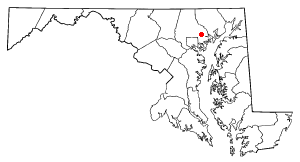Perry Hall, Maryland
|
|
Perry Hall is a census-designated place located in Baltimore County, Maryland. As of the 2000 census, the CDP had a total population of 28,705.
| Contents |
History
In 1774, wealthy planter Harry Dorsey Gough purchased an 1,000 acre (4 km²) estate called "the Adventure" north of present-day Belair Road. Gough renamed the estate "Perry Hall," after his family's home in Great Britain, and completed construction of the Perry Hall Mansion, which still stands in the northern part of the community. Harry Dorsey Gough, then, could be thought of as the founder of Perry Hall.
The Gough family dominated the life of the community until after the Civil War. The Gough plantation was among the largest in Baltimore County, and Harry Dorsey Gough was an early leader in the Maryland General Assembly, as well as a founder of the Methodist Church. It was at Perry Hall Mansion that plans for the American Methodist Church were developed by Gough, Francis Asbury, and other religious leaders. The Gough family later donated land for the construction of the Camp Chapel church and a community school.
The Civil War accelerated the end of plantation life in the United States. The Perry Hall estate was sold in 1875 to Eli Slifer of Philadelphia, who divided the property into farms of various sizes and sold the lots to immigrant families, many of whom were from Germany. That is how the tiny village came to be known as "Germantown." These farmers raised "stoop crops" like celery and carrots, and as the Twentieth Century opened, many families opened nurseries and flower shops.
Germantown, which rested near the intersection of Chapel and Belair Roads, was a small but self-sufficient farming village. The 1902 telephone directory listed only twenty-six numbers, including five saloon owners, seven storekeepers, four farmers, the justice of the peace, and undertaker, and the community schoolteacher. Mail delivery was done on horseback, and it was the only real way for one village to communicate with another. The community had its share of taverns and inns, and at the end of a long day in the fields, a trip to the local saloon was a nightly tradition for many. Local patrons were often joined by travelers on their way along Belair Road, a major turnpike from the city to the country.
With German and Irish immigration, new Catholic and Lutheran churches were built in the community. For most families, entertainment meant gathering together on the front porches of the farmhouses, where families would hold dances and young men would romance the girls from down the street. In time, the name "Germantown" disappeared from local maps, and the plantation moniker "Perry Hall" came to distinguish the growing village.
The period after World War Two transformed Perry Hall from rural hamlet into a suburban community. Recognizing the inevitable surge in development, the Perry Hall Improvement Association was established in 1945 to lobby for the necessary infrastructure to support the community. Its most successful endeavor was the Northeast Library Association, formed to acquire a new public library in Perry Hall. That effort culminated in 1963, when the Perry Hall library was dedicated by Baltimore County Executive Spiro T. Agnew, Congressman Clarence Long, and dozens of local leaders.
Perry Hall was changing, though, and signs of postwar urbanization were everywhere. as thousands of city residents bought homes in Perry Hall, the county built three new schools between 1956 and 1968. In 1961, the community's first shopping center was built at Ebenezer and Belair Roads.
Between 1980 and 1990, Perry Hall's population almost doubled, rising from 13,455 to 22,723 residents. The US Census Bureau estimates that over six thousand housing units were constructed over a ten-year period, most in the vast area behind Seven Courts and Gunpowder Elementary School.
Source: Baltimore County Public Library
Geography
Perry Hall is located at 39°24'5" North, 76°28'44" West (39.401385, -76.478962)Template:GR.
According to the United States Census Bureau, the CDP has a total area of 18.1 km² (7.0 mi²). 18.1 km² (7.0 mi²) of it is land and none of it is covered by water.
Demographics
As of the censusTemplate:GR of 2000, there are 28,705 people, 11,328 households, and 7,884 families residing in the CDP. The population density is 1,585.6/km² (4,104.8/mi²). There are 11,578 housing units at an average density of 639.5/km² (1,655.7/mi²). The racial makeup of the CDP is 88.79% White, 4.53% African American, 0.11% Native American, 5.08% Asian, 0.03% Pacific Islander, 0.37% from other races, and 1.10% from two or more races. 1.50% of the population are Hispanic or Latino of any race.
There are 11,328 households out of which 33.5% have children under the age of 18 living with them, 56.3% are married couples living together, 9.9% have a female householder with no husband present, and 30.4% are non-families. 23.8% of all households are made up of individuals and 7.2% have someone living alone who is 65 years of age or older. The average household size is 2.53 and the average family size is 3.03.
In the CDP the population is spread out with 24.2% under the age of 18, 7.4% from 18 to 24, 32.7% from 25 to 44, 24.0% from 45 to 64, and 11.6% who are 65 years of age or older. The median age is 37 years. For every 100 females there are 92.8 males. For every 100 females age 18 and over, there are 88.6 males.
The median income for a household in the CDP is $57,033, and the median income for a family is $65,632. Males have a median income of $42,371 versus $33,834 for females. The per capita income for the CDP is $26,361. 2.9% of the population and 2.3% of families are below the poverty line. Out of the total population, 3.5% of those under the age of 18 and 3.2% of those 65 and older are living below the poverty line.
External links
- Perry Hall Community Web Page (http://www.bcpl.net/~phia/)

